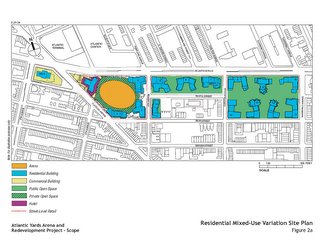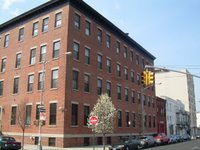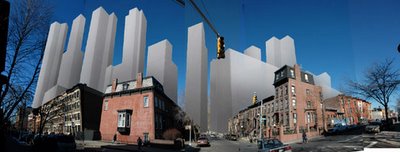 On the Brian Lehrer Show last Wednesday on WNYC radio, architecture critics Paul Goldberger (of the New Yorker) and Martin Filler (House and Garden and the New York Review of Books) discussed the legacy of the recently-deceased urbanist Jane Jacobs.
On the Brian Lehrer Show last Wednesday on WNYC radio, architecture critics Paul Goldberger (of the New Yorker) and Martin Filler (House and Garden and the New York Review of Books) discussed the legacy of the recently-deceased urbanist Jane Jacobs.At about 23:55 of the segment, a caller brought up the Atlantic Yards project. Filler concluded that Jacobs most likely would've disliked the project and Goldberger also leaned in that direction, though with more caveats. I think both would have been more confident in Jacobs's likely opposition had they understood more about the project and had considered Jacobs's likely reaction to past Forest City Ratner projects. I'll examine that below, following the transcript.
Transcript
 Rose in Brooklyn: I would like to talk about Brooklyn, about Atlantic Yards, because it seems to me that Jane Jacobs’ legacy is really being trashed in Brooklyn. I’ve read about suburban communities who are now trying to develop like cities, with organic neighborhoods, with people walking. And in Atlantic Yards, what would happen, if the development went up as planned, is that neighborhoods would be separated from each other and they would not be able to cross through there, it would be totally this enclave that was kind of plunked down in the middle of everything, so that Fort Greene would be cut off from Prospect Heights, both of them would be cut off from Boerum Hill and Park Slope, and it would be totally inorganic and just totally foreign. (Current site footprint above right.)
Rose in Brooklyn: I would like to talk about Brooklyn, about Atlantic Yards, because it seems to me that Jane Jacobs’ legacy is really being trashed in Brooklyn. I’ve read about suburban communities who are now trying to develop like cities, with organic neighborhoods, with people walking. And in Atlantic Yards, what would happen, if the development went up as planned, is that neighborhoods would be separated from each other and they would not be able to cross through there, it would be totally this enclave that was kind of plunked down in the middle of everything, so that Fort Greene would be cut off from Prospect Heights, both of them would be cut off from Boerum Hill and Park Slope, and it would be totally inorganic and just totally foreign. (Current site footprint above right.)
Brian Lehrer: Paul, do you know if Jane Jacobs actually commented on that program before she died-- (Current site plan at right, from the Empire State Development Corporation's Final Scope.)
Paul Goldberger: I do not know. It would be fascinating to know about that, actually. Obviously, one would assume that she would not have been enthusiastic about it. On the other hand, she also had a fascinating way of sometimes confounding all of us by looking at things freshly. One thing that I know Jane Jacobs did not like and was rather impatient with was the kind of reflexive formulaic application of her ideas. She and I once talked about that whole trend of replacement of huge suburban covered shopping malls with these sort of new pseudo-village places, with fake streets that also pretend to be little ersatz villages. Which one might think of as a way in which some of her ideas have actually percolated into the commercial mainstream and, indeed, they were that. But she was rightly offended by the fakery of it, by the pretense, and the utter disingenuousness of it.
 I think disingenuousness in urban planning and urban design offended her most of all. And whether she would’ve felt that Brooklyn was another example of disingenuousness raised to a high scale, or something that had a sort of an inherent quality of its own that she might have respected would’ve been very interesting to know, actually, and I don’t know that she ever spoke out on it. (Previous site plan at right, from the ESDC's Draft Scope.)
I think disingenuousness in urban planning and urban design offended her most of all. And whether she would’ve felt that Brooklyn was another example of disingenuousness raised to a high scale, or something that had a sort of an inherent quality of its own that she might have respected would’ve been very interesting to know, actually, and I don’t know that she ever spoke out on it. (Previous site plan at right, from the ESDC's Draft Scope.)Brian Lehrer: Even though, Martin, it’s a bunch of high-rises down there and it cuts off neighborhoods in the way that Rose says, it is mixed use in a certain sense, because--
Martin Filler: --‘Even though.’ I love the way she started--
Brian Lehrer: -- it’s an arena and residential development for various income levels, as well as the office towers and commercial space. Could it have been something she would be drawn to, on that basis?
 Martin Filler: I really, really seriously doubt it, an arena. I think the neighborhoods—the overlapping areas that the Atlantic Yards project comprises is a textbook example of that kind of pregentrified New York of old. Yes, there are parts that include some very expensive townhouses--even that part of Brooklyn has not been immune from the insane rise of real estate values, residential real estate values, particularly in New York. (Photo of Freddie's bar at Sixth Avenue and Dean Street.)
Martin Filler: I really, really seriously doubt it, an arena. I think the neighborhoods—the overlapping areas that the Atlantic Yards project comprises is a textbook example of that kind of pregentrified New York of old. Yes, there are parts that include some very expensive townhouses--even that part of Brooklyn has not been immune from the insane rise of real estate values, residential real estate values, particularly in New York. (Photo of Freddie's bar at Sixth Avenue and Dean Street.)But what is appalling about the scheme is the fact that I think that the city has kind of rolled over and played dead on the kind of redlining, as it were, of what gets to stay and what gets to go. And I did not see sufficient attention being paid to the low-income residents of the neighborhood and, furthermore, even if you find them another place to live, it doesn’t have that wonderful energizing sense of mixtures of people of diverse incomes living in close proximity.
What Jacobs might have thought
 I'd speculate that Jacobs, like some Brooklynites, would approach Forest City Ratner's Atlantic Yards project with some ingrained skepticism, based on the developer's much-criticized architecture and urban design at MetroTech, the Atlantic Center mall, and the Atlantic Terminal mall. (Photo at right of MetroTech on a Saturday afternoon, by Brian Carreira for the Brooklyn Rail.)
I'd speculate that Jacobs, like some Brooklynites, would approach Forest City Ratner's Atlantic Yards project with some ingrained skepticism, based on the developer's much-criticized architecture and urban design at MetroTech, the Atlantic Center mall, and the Atlantic Terminal mall. (Photo at right of MetroTech on a Saturday afternoon, by Brian Carreira for the Brooklyn Rail.)She might have worried that the project would create a superblock, with the closing of Pacific Street between Carlton and Vanderbilt avenues. She might not have been as conclusory as the WNYC caller about how the project cuts off neighborhoods--project proponents point out that the sunken railyard also cuts off neighborhoods, which is why development of some sort makes sense.
But she probably would've looked closely at the new planning principle added to the Final Scope, possibly a response to alternative plans that would have continued the street grid from Fort Greene: "Creation of visual and pedestrian corridors from Fort Greene going south into and through the proposed project’s open space and connecting surrounding neighborhoods." However, visual and pedestrian corridors do not a street grid make, and the map above from the Final Scope does not seem that different from the plan in the Draft Scope, except for some changes in the east side of the project.
 As for disingenuousness, Jacobs might have been concerned about the developer's deceptions regarding the Atlantic Yards project as well as jobs at the Atlantic Center mall. And surely she would've been concerned about the design at Atlantic Center (right), which violates her precepts about encouraging street life by setting up barriers to entry by residents of subsidized housing adjacent to the mall. That's not to say that Forest City Ratner hasn't learned from past mistakes; it's just that they can't be ignored.
As for disingenuousness, Jacobs might have been concerned about the developer's deceptions regarding the Atlantic Yards project as well as jobs at the Atlantic Center mall. And surely she would've been concerned about the design at Atlantic Center (right), which violates her precepts about encouraging street life by setting up barriers to entry by residents of subsidized housing adjacent to the mall. That's not to say that Forest City Ratner hasn't learned from past mistakes; it's just that they can't be ignored.Would Atlantic Yards truly be a mixed-use project? Jacobs might simply have consulted the 11/6/05 New York Times, which, examining the changes in jobs and housing, called the project essentially a large residential development with an arena and a relatively small amount of office and retail space attached to it.
Pregentrified?
Critic Filler, I believe, was fuzzy in describing the area of the Atlantic Yards project as pregentrified. The neighborhoods around the project have gentrified significantly, though there is a significant component of subsidized housing, from row houses to high-rises, north of the project border within the Atlantic Terminal Urban Renewal Area (ATURA).
 The footprint itself contains a mix of buildings in various stages from renovation to disrepair, as well as railyards that were never development, so only part of it could be called pregentrified. (See Forgotten NY for the range.) I suspect Jacobs would wonder why former industrial buildings recently renovated into housing, such as the Spalding factory at right, would be sacrified for high-rise development. The response would be that new construction would bring more density and more affordable housing.
The footprint itself contains a mix of buildings in various stages from renovation to disrepair, as well as railyards that were never development, so only part of it could be called pregentrified. (See Forgotten NY for the range.) I suspect Jacobs would wonder why former industrial buildings recently renovated into housing, such as the Spalding factory at right, would be sacrified for high-rise development. The response would be that new construction would bring more density and more affordable housing.Indeed, Filler's question of whether "sufficient attention [is] being paid to the low-income residents of the neighborhood" is a complex one. The several dozen rent-stabilized tenants currently in the footprint could ultimately move back into the project after vacating their buildings; however, their transitional rent would only be subsidized for three years, and they'd have to desist from any criticism of the project.
 Jacobs, I think, would question the scale of the project--significantly discontinuous with most of its surroundings--and wonder whether the scale was driven by the need to include both affordable housing (2250 units) for political support and market-rate housing (4610 units) to generate sufficient profit. Project supporters contrast Atlantic Yards with market-rate towers in Downtown Brooklyn that include no affordable housing. The absence of affordable housing is hardly defensible, but the scale of those buildings was negotiated publicly as part of a rezoning.
Jacobs, I think, would question the scale of the project--significantly discontinuous with most of its surroundings--and wonder whether the scale was driven by the need to include both affordable housing (2250 units) for political support and market-rate housing (4610 units) to generate sufficient profit. Project supporters contrast Atlantic Yards with market-rate towers in Downtown Brooklyn that include no affordable housing. The absence of affordable housing is hardly defensible, but the scale of those buildings was negotiated publicly as part of a rezoning.Affordable housing
For Atlantic Yards, the affordable housing component was negotiated by the developer and ACORN, rather than any public representatives, and the scale of the project is up to the unelected Empire State Development Corporation rather than an elected city body. So Jacobs, I think, would want more public discussion of the scale, via efforts like the mock-up (above) by OnNYTurf.
Also, Filler's comment could be examined in terms of the project's potential effect on not merely on affordable housing in the project footprint, but on displacement via rising rents in the surrounding areas.
Comments
Post a Comment